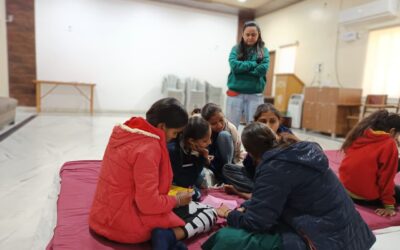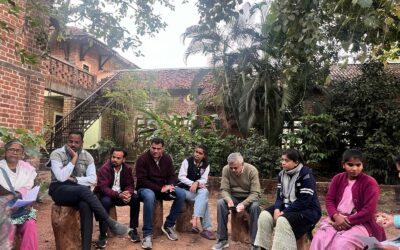Kutch, the largest district in India, sprawls across vast expanses, including the renowned Rann of Kutch, with a sparse population density. It is a land of stark beauty, known for its vast arid plains, unique ecosystems, and rich cultural heritage. The Rann is a haven for migratory birds like flamingos, and the Banni grasslands support an array of wildlife, from the endemic spiny-tailed lizard to thousands of migratory birds that reach Banni, when its dry tracts transform into lush wetlands after the monsoon. carbon
For more than four centuries, Kutch has been home to more than 20 ethnic semi-nomadic communities. These include the Maldharis who practice pastoralism – breeding cattle, buffaloes, goats, sheep and camels. The Jats who engage in fishing, and several others who have been traditional agriculturists. Some of these communities adapt to the vagaries of the water-limited and seemingly resource-poor land by migrating seasonally with their prized native livestock breeds.
The Mad Trees
There was a pivotal moment in this landscape in the 1950s and 60s. To slow down the desertification, a foreign species named Prosopis Juliflora was introduced in the region. Also called the mad tree or gando baval in local dilect. It is a drought tolerant, salt resistant tree which fixes nitrogen in the soil. These qualities made it seem like the perfect solution to stop the encroachment of the Rann of Kutch. carbon
We used to distribute the seeds of the prosopis juliflora, thinking it as a way to earn punya (virtue)
Dipesh Shorff, founder of Agrocel Industries who has witnessed the slow degradation of the Banni grasslands
However, prosopis’ aggressive growth has had unintended consequences. It has out-competed native grasses, drastically changing the landscape in Banni. It has resulted in loss of grazing land, endangered the native fauna like the “chinkara” and “houbara bustard”, and depleted groundwater in the region due to its deep roots.
A study published in 2021 states that large scale removal of the prosopis is not a viable solution, as communities have begun depending on it for charcoal production. Some of the cattle also feed on it, like the Banni Buffalo, whose population has increased 6% between 1977 and 2012. Instead, the study proposes a strategic and sustainable approach to removing the invasive species, minimising the impact on livelihoods or providing adequate transition time for affected communities. The study also indicates that prosopis needs to be removed continuously for three consecutive years from a patch of land to significantly reduce the chances of regrowth.
Possible Solutions carbon
Communities here produce charcoal from these trees using the earth mound kilns. They spent around five days to create the mound of wood, and the kiln is lit for the next five i days. It requires continuous attention when it is lit, day and night. With 8-12% efficiency and lots of pollution. This process is not sustainable, especially on a larger scale. Another solution is the production of Biochar.
Biochar is very similar looking to charcoal, except that it is produced in a low oxygen environment, a process of modern pyrolysis carried out in a reactor machine. It is a high-carbon, fine-grained residue which helps in reducing the carbon emission.
The process results in a mixture of products:
- Biochar: The solid residue with stable carbon composition
- Bio-oil: A liquid product
- Syngas: A gaseous product

Why Biochar
Biochar looks similar to common charcoal but is specifically produced to reduce contamination and safely store carbon. It stands at the intersection of sustainability, agriculture, and environmental stewardship. Organic matter like plants take carbon during photosynthesis and store it with them. After they die/decompose, this stored carbon gets released back into the atmosphere. If this latter release is stopped, we can say we reduced some amount of carbon from the atmosphere and contributed positively in climate change mitigation. Biochar is a way to do just that.
Biochar has shown promise in improving soil quality. Studies have shown it can increase nutrient retention, improve water holding capacity, and even aid in plant growth. This makes it a potential tool for sustainable agriculture and land management.
Carbon Credits
Let’s say a steel firm emits some carbon, and can’t really stop emitting it immediately. It is working on a plan where its plant will be completely renewable after ten years. But during this time, it wants to offset its emissions. So what it can do is fund carbon mitigation projects elsewhere. The way to do this are carbon credits. A carbon credit is a certificate or permit that represents a reduction in carbon emissions, with one credit representing one metric ton of CO2. They can be bought on the voluntary carbon market (VCM) to compensate for an entity’s own greenhouse gas emissions. VCM is a marketplace which facilitates the buying and selling of the credits. So the steel firm can buy carbon credits to reach its net-zero targets.
Way Forward
Sahjeevan, my fellowship host organization, envisions a self-sustaining future where community associations themselves can initiate creating biochar from the gando baval. We actively support the community, whether it’s by guiding biochar production or facilitating carbon credit claims with private companies. This initiative not only generates income for the community members, but also sequesters carbon and improves soil health. Looking ahead, this holistic approach will lead to a flourishing ecosystem with increased biodiversity, improved water availability, and a significant expansion of grazing land.




Ganda Bavad has integrated into environmental and economical systems of Kutch, the real loss is loss of Meetha Bavad..the native shrub which is far more beneficial to the ecosystem. Going after the nitrogen fixation has led to degradation of carbon. Biochar does seem like a viable option at this stage…would love to see how the communities adopt it.